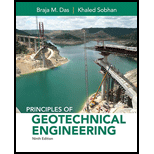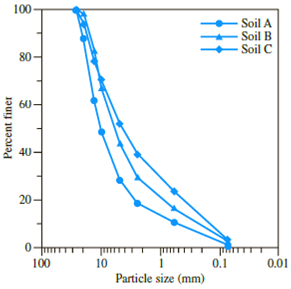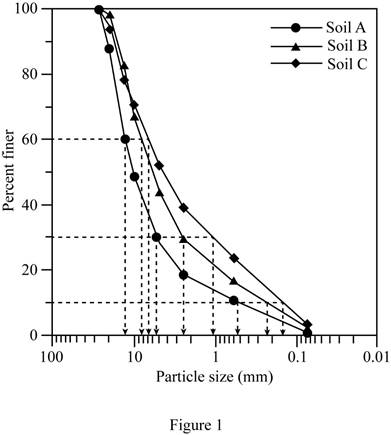
Three groups of students from the

(a)

(b)
Figure 2.35 (a) Soil-aggregate stockpile; (b) sieve analysis (Courtesy of Khaled Sobhan, Florida Atlantic University, Boca Raton, Florida)
a. Determine the coefficient of uniformity and the coefficient of gradation for Soils A, B, and C.
b. Which one is coarser: Soil A or Soil C? Justify your answer.
c. Although the soils are obtained from the same stockpile, why are the curves so different? (Hint: Comment on particle segregation and representative field sampling.)
d. Determine the percentages of gravel, sand and fines according to Unified Soil Classification System.
(a)
Calculate the coefficient of uniformity (Cu) and coefficient of gradation (Cc) for soils A, B, and C.
Answer to Problem 2.1CTP
The uniformity coefficient of soil A is 26.42_.
The coefficient of gradation of soil A is 3.64_.
The uniformity coefficient of soil B is 35_.
The coefficient of gradation of soil B is 3.35_.
The uniformity coefficient of soil C is 46.67_.
The coefficient of gradation of soil C is 1.15_.
Explanation of Solution
Sketch the grain size distribution curve for soils A, B, and C as shown in Figure 1.

Refer to Figure 1.
For soil A:
The diameter of the particle corresponding to 60% finer (D60) is 14 mm.
The diameter of the particle corresponding to 30% finer (D30) is 5.2 mm.
The diameter of the particle corresponding to 10% finer (D10) is 0.53 mm.
For soil B:
The diameter of the particle corresponding to 60% finer (D60) is 8.1 mm.
The diameter of the particle corresponding to 30% finer (D30) is 2.5 mm.
The diameter of the particle corresponding to 10% finer (D10) is 0.23 mm.
For soil C:
The diameter of the particle corresponding to 60% finer (D60) is 7 mm.
The diameter of the particle corresponding to 30% finer (D30) is 1.1 mm.
The diameter of the particle corresponding to 10% finer (D10) is 0.15 mm.
Calculate the uniformity coefficient (Cu) using the relation.
Cu=D60D10 (1)
For soil A:
Substitute 14 mm for D60 and 0.53 mm for D10 in Equation (1).
Cu=140.53=26.42
Hence, the uniformity coefficient for soil A is 26.42_.
For soil B:
Substitute 8.1 mm for D60 and 0.23 mm for D10 in Equation (1).
Cu=8.10.23=35
Hence, the uniformity coefficient for soil B is 35_.
For soil C:
Substitute 7 mm for D60 and 0.15 mm for D10 in Equation (1).
Cu=70.15=46.67
Hence, the uniformity coefficient for soil C is 46.67_.
Calculate the coefficient of gradation (Cc) using the relation.
Cc=D230D60×D10 (2)
For soil A:
Substitute 14 mm for D60, 5.2 mm for D30, and 0.53 mm for D10 in Equation (2).
Cc=5.2214×0.53=27.045.512=3.64
Hence, the coefficient of gradation for soil A is 3.64_.
For soil B:
Substitute 8.1 mm for D60, 2.5 mm for D30, and 0.23 mm for D10 in Equation (2).
Cc=2.528.1×0.23=6.251.863=3.35
Hence, the coefficient of gradation for soil B is 3.35_.
For soil C:
Substitute 7 mm for D60, 1.1 mm for D30, and 0.15 mm for D10 in Equation (2).
Cc=1.127×0.15=1.211.05=1.15
Therefore, the coefficient of gradation for soil C is 1.15_.
(b)
State which of the soil is coarser from soil A and C.
Answer to Problem 2.1CTP
Soil A is coarser than soil C.
Explanation of Solution
Refer to part (a).
The uniformity coefficient of soil A is 26.42.
The uniformity coefficient of soil C is 46.67.
The percent of soil finer than 1 mm for soil A is 20%.
The percent of soil finer than 1 mm for soil C is 47%.
Hence, a higher percentage of soil C is finer than soil A.
Hence, soil A is coarser than soil C.
(c)
Explain the reason for curve different of soil A, B and C if it is obtained from same stockpile.
Explanation of Solution
The particle-size distribution curve shows the range of particle sizes present in a soil and the type of distribution of various-size particles.
Refer to Figure 1.
Particle separation of coarser and finer particles may take place in aggregate stockpiles. This makes representative sampling difficult.
Therefore, the particle-size distribution curve is different for soils A, B, and C.
(d)
Calculate the percentages of gravel, sand, and fines according to the Unified Soil Classification System.
Answer to Problem 2.1CTP
The percentage of gravel for soil A is 71%_.
The percentage of sand for soil A is 28%_.
The percentage of fines for soil A is 1%_.
The percentage of gravel for soil B is 55%_.
The percentage of sand for soil B is 43%_.
The percentage of fines for soil B is 2%_.
The percentage of gravel for soil C is 47%_.
The percentage of sand for soil C is 50%_.
The percentage of fines for soil C is 3%_.
Explanation of Solution
Refer to Figure 1.
For soil A.
The percent passing through 4.75 mm sieve is 29%.
The percent passing through 0.075 mm sieve is 1%.
Calculate the percentage of gravel as shown below.
Percent of gravel=100−percent passing through 4.75 mm sieve=100−29=71%
Hence, the percentage of gravel is 71%_.
Calculate the percentage of sand as shown below.
Percent of sand=(percent passing through 4.75 mm sieve)−(percent passing through 0.075 mm sieve)=29−1=28%
Hence, the percentage of sand is 28%_.
Calculate the percentage of fines as shown below.
Percent of fines=percent passing through 0.075 mm sieve−0=1−0=1%
Hence, the percentage of fines is 1%_.
Refer to Figure 1.
For soil B.
The percent passing through 4.75 mm sieve is 45%.
The percent passing through 0.075 mm sieve is 2%.
Calculate the percentage of gravel as shown below.
Percent of gravel=100−percent passing through 4.75 mm sieve=100−45=55%
Hence, the percentage of gravel is 55%_.
Calculate the percentage of sand as shown below.
Percent of sand=(percent passing through 4.75 mm sieve)−(percent passing through 0.075 mm sieve)=45−2=43%
Hence, the percentage of sand is 43%_.
Calculate the percentage of fines as shown below.
Percent of fines=percent passing through 0.075 mm sieve−0=2−0=2%
Hence, the percentage of fines is 2%_.
Refer to Figure 1.
For soil C.
The percent passing through 4.75 mm sieve is 53%.
The percent passing through 0.075 mm sieve is 3%.
Calculate the percentage of gravel as shown below.
Percent of gravel=100−percent passing through 4.75 mm sieve=100−53=47%
Hence, the percentage of gravel is 47%_.
Calculate the percentage of sand as shown below.
Percent of sand=(percent passing through 4.75 mm sieve)−(percent passing through 0.075 mm sieve)=53−3=50%
Hence, the percentage of sand is 50%_.
Calculate the percentage of fines as shown below.
Percent of fines=percent passing through 0.075 mm sieve−0=3−0=3%
Hence, the percentage of fines is 3%_.
Want to see more full solutions like this?
Chapter 2 Solutions
Principles of Geotechnical Engineering (MindTap Course List)
- how to manually plotting by coordinatesarrow_forwardmapping surveys/mappingarrow_forwardQuestion 3 (15pt) A traffic signal control is being designed for a four-leg intersection on a divided highway with the characteristics show in the table below. Determine an appropriate length of the yellow interval for each approach. (assuming the average vehicle length is 20ft, and the perception-reaction time is 1.0 sec, and deceleration rate of 11.2ft/sec²) Median width (ft) Number of 12ft lanes on each approach Design speed (mph) Grade North South approaches East West Approaches 18 3 45 0 10 2 35 3.5 SPEED LIMIT 45 18ft SPEED LIMIT 45 5arrow_forward
- Hi! Can you help me compute the concrete and masonry works for this structure based on the attached elevation drawing?The image shows the side view of a small building with labeled sections, wall openings (windows), and dimensions in centimeters. Specifically, I need help computing the following: For Concrete Works: Volume of concrete for footings, columns, and slab (if applicable) For Masonry Works (CHB Walls): Total wall area (excluding window openings) Number of CHBs required (based on 0.4 m x 0.2 m CHB) Cement and sand for block laying Cement, sand, and gravel for core filling (if reinforced) Cement and fine sand for plastering (both sides) Rebars needed for CHB reinforcement (if any) Please base it on the drawing dimensions. Let me know if additional assumptions or standards are needed (e.g., CHB size, mix ratio, thickness of plaster). Thank you!arrow_forwardHi! Can you help me compute the Masonry Works for the 3rd Floor only based on this image?This image shows all my completed concrete, rebar, slab, and formwork computations for the 3rd floor of a 3-storey residential building. Specifically, I need the following for CHB walls: Quantity of CHB Cement & sand for block laying (mortar) Cement, sand, and gravel for core filling Cement & fine sand for plastering Cement, sand, and gravel for CHB wall footing Number and length of vertical & horizontal rebars (10mm or as required)arrow_forwardP16.11 WP An assembly consisting of tie rod (1) and pipe strut (2) is used to support an 80 kip load, which is applied to joint B. Strut (2) is a pin-connected steel [E = 29,000 ksi] pipe with an outside diameter of 8.625 in. and a wall thickness of 0.322 in. For the loading shown in Figure P16.11, determine the factor of safety with respect to buckling for member (2). A C 24 ft B 80 kips FIGURE P16.11 12 ft 30 ftarrow_forward
- Hi! Based on the computations I've already completed for the second floor (shown in the attached image), can you help me compute the required materials for masonry works? Specifically, I need the following: Total quantity of CHB (Concrete Hollow Blocks) Cement and sand for block laying (mortar) Cement, sand, and gravel for CHB core filling Cement and fine sand for plastering Cement, sand, and gravel for CHB footing with pest control Reinforcing steel bars (vertical and horizontal) Please assume standard block size (e.g., 0.4m x 0.2m x 0.2m) and standard mortar/plaster thickness if not specified. Thank you!"arrow_forwardHi! I would like helping hand in computing all the materials needed for masonry works (CHB walls) on the ground floor. I’ve already computed the other structural elements — please refer to the attached image.arrow_forwardHi! Kindly help me compute the following based on the attached elevation plan and floor plan: Total Perimeter of the building – to be used for layouting. Total Length of Batter Board – include all sides where batter boards will be installed. Number and spacing of Stakes – assuming a stake is placed every 1.2 meters along the perimeter. Please show the complete solution and breakdown of your computation. Thank you!arrow_forward
- E D (B) (<) 2945 3725 250 2225 Car Port 5000 2500 Pool Area 2 3925 3465 2875 13075 Staff Room Bar Counter 1 GROUND FLOOR PLAN SCALE 1:100 Hallway 3 1560 4125 3125 $685 Laundry & Service Area 5 A Common T&B Kitchen & Dining Arear B Living Area 2425 Terrace E 2 12150 1330 2945 4150 5480 1800 3725 1925 3800 3465 2 3 9150 4125 3575 3925 Terrace Toilet & Bathroom Toilet Bathroom Bedroom 1 Bedroom 2 SECOND FLOOR PLAN SCALE Hallway 1:100 OPEN TO BELOW E B A 3 3725 2150 1330 2945 5480 4150 1925 ⑨ 2 9150 3800 4125 3465 3575 3925 Terrace R Toilet & Bathroom Toilet & Bathroom SECOND FLOOR PLAN SCALE Hallway 1:100 OPEN TO BELOW +arrow_forwardQ2/ In a design of a portable sprinkler system, the following information is given: • • The sprinklers are distributed in a square pattern with radius of the wetted circle of the sprinkler=15 m Consumption rate = 10 mm/day Efficiency of irrigation = 60% Net depth of irrigation (NDI)= 80 mm. Find the following: 1-Sprinkler application rate if HRS = 11. 2-Number of pipes required for irrigation. (50 Marks) 3-Discharge of sprinkler, diameter of nozzle, and the working head pressure if C=0.90. 4-Diameter of the sprinkler pipe for Slope=0. 5-Pressure head at the inlet and at the dead end of the sprinkler pipe for Slope=0. (F² + L²)((SF)² + L²) L² 2L² ≤ D² L² + S² ≤ D² A, = * 1000 S*L ≤D² N W Af m-11-P L' Hf = 1.14*109 * 1.852 * L *F,where c=120 D4.87 Source main pipe 180 m 540 m N 1 1 √m-1 F = im/Nm+1 = + + m+1 2N 6N2 i=1 Nozzle diameter (mm) 3< ds 4.8 4.8< ds 6.4 6.4arrow_forwardMiniatry of Higher scent Research University of Ke Faculty of Engineering Cell Engineering Department 2024-2025 Mid Exam-1 st Attempt Time Date: 17/04/2025 Notes: Answer all questions. Not all figures are to scale. Assume any values if you need them. Q1/ A farm with dimensions and slopes (50 Marks) = shown in the figure below. If you asked to design a border irrigation system and if you know that Net depth of irrigation - 96mm .Manning coefficient = 0.15, Time of work in the farm is 6 hours/day. Design consumption use of water from the crop (ET) 16 mm/day, Width of the agricultural machine equal to 2.5m, Equation of infiltration - D= 12-05 and Efficiency of irrigation= 60%. You can neglect the recession lag time. Find the width and number of the borders, Irrigation interval and time required to irrigate the whole farm, Depth of flow in the inlet of border Number of borders that irrigated in one day and The neglected recession lag time Slope of irrigation % Maximum border width 0-0.1 30…arrow_forward
 Principles of Geotechnical Engineering (MindTap C...Civil EngineeringISBN:9781305970939Author:Braja M. Das, Khaled SobhanPublisher:Cengage Learning
Principles of Geotechnical Engineering (MindTap C...Civil EngineeringISBN:9781305970939Author:Braja M. Das, Khaled SobhanPublisher:Cengage Learning Traffic and Highway EngineeringCivil EngineeringISBN:9781305156241Author:Garber, Nicholas J.Publisher:Cengage Learning
Traffic and Highway EngineeringCivil EngineeringISBN:9781305156241Author:Garber, Nicholas J.Publisher:Cengage Learning Fundamentals of Geotechnical Engineering (MindTap...Civil EngineeringISBN:9781305635180Author:Braja M. Das, Nagaratnam SivakuganPublisher:Cengage Learning
Fundamentals of Geotechnical Engineering (MindTap...Civil EngineeringISBN:9781305635180Author:Braja M. Das, Nagaratnam SivakuganPublisher:Cengage Learning Construction Materials, Methods and Techniques (M...Civil EngineeringISBN:9781305086272Author:William P. Spence, Eva KultermannPublisher:Cengage Learning
Construction Materials, Methods and Techniques (M...Civil EngineeringISBN:9781305086272Author:William P. Spence, Eva KultermannPublisher:Cengage Learning Principles of Foundation Engineering (MindTap Cou...Civil EngineeringISBN:9781337705028Author:Braja M. Das, Nagaratnam SivakuganPublisher:Cengage Learning
Principles of Foundation Engineering (MindTap Cou...Civil EngineeringISBN:9781337705028Author:Braja M. Das, Nagaratnam SivakuganPublisher:Cengage Learning




